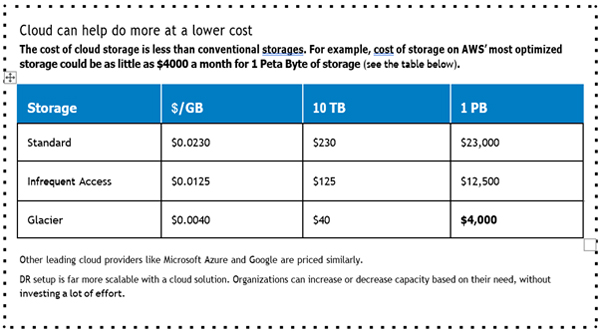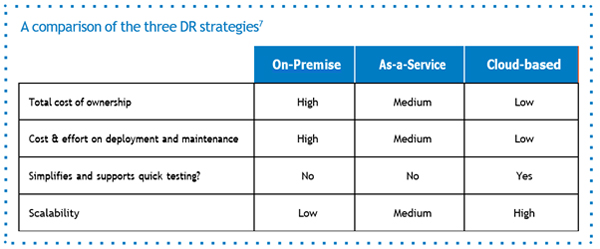-
-
Like what you see?
LetsTalkUrl
Let's Talk
When agencies transform their IT systems to address the digital imperative, one thing that doesn’t get the attention it deserves is disaster recovery (DR).
Being more digital means being more dependent on technology. This increases the risk of disruption due to cyberattacks, natural disasters or hardware/software failures. Any disruption can have significant financial and security impact, especially for public sector organizations that manage sensitive data.
The frequency and severity of these disruptions appears to be increasing. For example, in 2016 the IRS had to stop accepting electronically filed tax returns due to a hardware failure1. In 2015, a significant equipment failure at one of the data centers brought down a number of federal government websites in Canada2. And more recently, an error brought down US State Department’s email service for half-a-day3.
These outages impact workers’ ability to do their job, they impact constituents, and they are extremely expensive - the average cost of downtime can range from $5600 per minute4 to $8000 per minute5. This can be prohibitive for public sector organizations, especially if they take days6 to recover from a disruption.
To minimize the cost and the broader impact of a disruption, public sector organizations need to keep their business continuity plans updated. A highly responsive disaster recovery solution with sub-second Recovery Period Objective (RPO) and Recovery Time Objective (RTO) is a critical component of this plan. Meeting these requirements through traditional DR models can be expensive.
Typically, public sector organizations use either of these two approaches for their disaster recovery solution:
The physical or off-site DR approach can offer very short RPO and RTO (Hot DR), but also requires extensive investments in hardware (duplicate servers), software licenses, DR infrastructure and services (data protection software, replication software, high-speed connectivity etc.), and management (IT staff for maintenance & support of the DR systems).
A large enterprise (with more than 750 servers) may spend an average of $11 Mn/year to setup and maintain a physical DR site. This is a significant amount of money, especially for budget constrained public sector organizations7.
Disaster Recovery As-a-Service (DRaaS) offers a cheaper alternative. With DRaaS, organizations leverage a third party vendor to provide DR infrastructure and services. The third-party hosts physical or virtual servers, generally on a cloud, for an organization. DRaaS uses a backup or snapshot-based approach to sync data between production and recovery sites.
The third-party manages the hardware and software, services and monitors the DR solution and is responsible for providing failover according to the defined service level agreements.
With DRaaS, a large enterprise may spend less on its DR setup as compared to the physical or off-site model. However, if the DRaaS setup uses a snapshot based replication technology, then the organization is unlikely to realize sub-second RPO & RTO7.
The other challenge with these two options is the testing of the DR setup. Ideally, a DR system should be tested every six months.
This requires planning and provisioning of resources, including staff time which is already in short supply. Testing a physical DR setup or a DRaaS setup can take days and a lot of commitment from many people.
Organizations spend a lot of effort and money in maintaining the DR setup – facility costs, maintenance of duplicate resources (hardware and software licenses), manpower etc.
Cloud-based DR that uses block-level continuous data-replication and helps an agency provision the resources when needed instead of all the time can not only help achieve sub-second RPO but also lower cost by up to 80%.

Back-up or snapshot based approaches sync-up data in distinct intervals. This means no near-zero RPO and significant expense (in terms of data transfer costs). Real-time replication can deliver sub- second RPO and optimize data transfer cost, but can also impact performance of existing systems.
Continuous block-level replication technologies offer a effective alternative, providing a highly responsive DR solution at a fraction of the cost. This approach captures changes (including but not limited to files, file system changes, RAID configurations, databases, OS configuration etc.) in real-time and replicates only those changes to the target location in an asynchronous manner. Not only does this minimize the impact on the performance of existing operations but this approach also delivers sub-second RPO in case of failover.
Organizations can further reduce cost of their DR setup by replicating data in a staging area, instead of the target environment, and using automated tools to quickly clone the data from the staging area to the target environment in case of a disaster.
With this approach, organizations:
Not only is this option cheaper – a large enterprise may have to spend as little as $650K to setup its DR systems 7 – but also offers a number of benefits including:

There are multiple cloud-based DR solutions. Some may not support all the applications or work with any cloud provider, some may impact server performance, and some may not deliver the required RTO or RPO. Block-level replication and a low-cost staging area are just a couple of factors that organizations should consider while selecting a cloud- based DR solution. Some others include:
As cloud technology evolves, organizations may need to convert their servers from the old infrastructure to the cloud of their choice. A solution that offers automated conversion would score over any other solution since it will make it easier for organizations to switch between infrastructures and keep their solution current without spending too much time and effort.
Since data and information are being replicated, the solution should encrypt the data using the most powerful models and should also support data transmission through private networks like an organization’s own VPN.
DR testing is important. The solution should offer options to conduct tests quickly, cost- effectively, and without extensive planning or preparation.
The digital imperative and the increasing frequency and severity of attacks –physical, cyber, and human - are making disaster recovery more crucial than ever. Public sector organizations need to ensure that their disaster recovery solution can help them recover within seconds. Doing this with traditional approaches (on-premise, DRaaS) can be costly. Moving DR to the cloud provides public sector organizations with the opportunity to implement a highly secure, enterprise-grade disaster recovery solution at a savings of up to 80%.